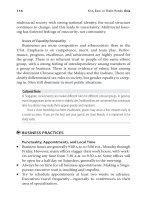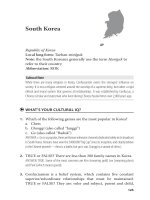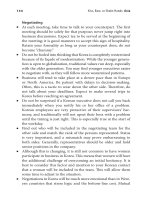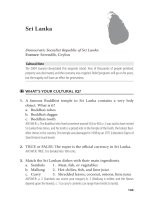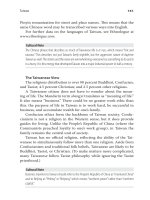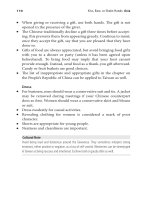How to Do Business in 12 Asian Countries 15
Bạn đang xem bản rút gọn của tài liệu. Xem và tải ngay bản đầy đủ của tài liệu tại đây (163.64 KB, 9 trang )
●
Flattery by means of “verbal promotion” is common in the Philip-
pines. A police ocer may be referred to as “Captain,” a police
captain may be called “Major,” and so on.
Gestures
●
A great deal of information can be communicated via eye contact
and eyebrow movement. Filipinos may greet each other by mak-
ing eye contact followed by raising and lowering the eyebrows.
●
A traditional Filipino may demonstrate respect upon greeting
an elder by placing the elder’s hand or knuckles on his or her
forehead.
●
Because of the years of U.S. military presence in the Philippines,
most North American gestures are recognized.
●
e foremost obscene gesture in both the USA and the Philippines
involves an extended middle nger. However, in the Philippines,
that nger is pointed at the person or thing being insulted.
●
Since pointing can easily be taken for an insulting gesture, Filipinos
rarely indicate objects or directions by pointing with their ngers.
Instead, they indicate with a glance or by pursing their lips.
●
Indicating “two” with the ngers is done by holding up the ring
and little nger, instead of the forenger and middle nger. e
thumb is not used to count numbers in the Philippines.
●
Staring has various nuances in the Philippines, most of them
negative. Foreigners should avoid staring at Filipinos, who can
easily interpret a stare as belligerence. If you are stared at, look
away.
●
As in much of the world, to beckon someone you hold your hand
out, palm downward, and make a scooping motion with the
ngers. Beckoning someone with the palm up and wagging one
nger, as in the USA, can be construed as an insult.
●
To stand tall with your hands on your hips—the “arms akimbo” or
“osides” position in soccer—is always interpreted as an aggres-
sive posture. Worse, it expresses an aggressive challenge—and in
the Philippines, belligerence is oen met with belligerence.
●
Looking down is useful to avoid giving oense when making one’s
way through a crowd or between two people who are conversing.
Philippines
10 7
10 8
Kiss, Bow, or Shake Hands: Asia
is may also be accompanied by an outstretched, at hand (like
a karate chop) or with both hands clasped together; the hand(s)
are in front, preceding the direction of motion.
●
A Filipino may try to attract your attention by brushing a nger
against your elbow.
Gifts
●
Gi giving is an important part of Filipino society. Flowers and
food are the most common gis, although there are situations in
which a handful of small coins is traditional.
●
When invited to a Filipino home, bring (or have sent before you
arrive) owers or a delicacy to your hostess. Avoid bringing alco-
hol or a substantial food, as this may imply that your host cannot
serve enough to satisfy guests.
●
However, exceptions are made for a specialty dish or food that
only you can provide, such as a recipe from your home country. A
thank-you note is appropriate aerward; some people also send a
small gi.
●
Aer a dinner party, Filipinos oen give their guests extra food to
take home, an ancient tradition called pabaon.
●
At Christmas, you will be expected to give a token gi—such as a
company calendar—to seemingly everyone you know or do busi-
ness with. Your list should include everyone who works for you,
all service personnel you deal with regularly (your postal clerks,
your security guards), and anyone who makes your life easier
by cooperating with you, such as the secretary of an important
client.
●
Filipinos follow the Asian habit of not opening gis in the pres-
ence of the giver. Traditionally, if the recipient is not happy with
the gi, he or she avoids embarrassment by opening it away from
the giver. Furthermore, Filipinos abhor appearing greedy; to
open a gi immediately would give this impression. Do not be
dismayed if your gi is casually set aside and ignored; you will be
thanked for it at a later date.
●
For further suggestions on appropriate gis in the Philippines,
visit www.kissboworshakehands.com.
Cultural Note
Foreigners are honored in the Philippines by being invited to family events: weddings,
anniversaries, baptisms, and so on. It is an even greater honor to be asked to participate in
such events as a sponsor in a wedding or a godparent in a baptism. Bring a gift, whether you
are a guest or a participant. These events are part of establishing the personal relationships
that are all-important in Filipino business practices.
Dress
●
Because of the heat and humidity, business dress for Filipinos
is oen casual: dark trousers and white, short-sleeved shirts for
men, without a tie; white long-sleeved blouses and skirts or pant-
suits for women. Despite this simplicity, these clothes will be neat,
clean, and fashionable. Filipinos are very style conscious.
●
You should dress conservatively until you are sure what degree of
formality is expected. Men should wear a suit and tie; business-
women wear white blouses and dark suits, pantsuits, or skirts.
●
Many Filipino men wear an embroidered shirt called a barong
tagalog. It is worn without a tie and hangs outside the trousers,
untucked. Long-sleeved ones are oen worn to work and to semi-
formal occasions; short-sleeved ones are for casualwear.
●
Men may wear a business suit for formal occasions, such as the the-
ater, a formal dinner party, and so forth, but women are expected
to wear a cocktail dress. Long evening gowns are required only on
rare occasions, such as diplomatic functions.
●
Neither men nor women should wear shorts or sandals in public,
except at the beach. Because Filipinos are so competitively fash-
ionable, some oces require their workers to wear uniforms.
●
Don’t wear anything outside that can be damaged by water during
a esta. Drenching pedestrians is a favorite esta pastime.
Cultural Note
Filipinos consider everyone worthy of respect. The more important you are, the more you are
expected to be humble and generous. Even the requests of a Filipino beggar are rejected with
the phrase “Patawarin po” (Forgive me, sir). The Filipino is literally apologizing to the beggar
for not giving him anything. Never brusquely dismiss anyone in the Philippines.
Philippines
10 9
110
Singapore
Republic of Singapore
Cultural Note
Singapore remains a booming center of capitalism in Southeast Asia. It is considered
exceptionally safe (even antiseptic), however, visitors should remember that Singapore’s
myriad laws apply to natives and foreigners equally. Before arrival, travelers should become
familiar with these laws: for example, no littering, no non-prescription chewing gum, no
illegal drugs, no pornographic materials, no weapons, no jaywalking, no spitting, and no
smoking in most public places. There is speculation that some of these stringent laws will ease
in the future, but to date, they are unfailingly enforced.
●
3
WHAT’S YOUR CULTURAL IQ?
1.
Which of the following is true about driving in Singapore?
a. Singapore enforces trac regulations with cameras that moni
-
tor violations.
b. Many Singaporeans drivers are unpredictable on the road.
c. A branch with green leaves adorning a stopped car indicates
that the vehicle has broken down.
d. Cars are driven on the le side of the road.
e. All of the above are true.
ANSWER: e. Traffic is a combination of high-tech (cameras), tradition (a branch stuck in the
bumper of a broken-down car), and temperaments.
2.
e government of Singapore applies its draconian legal code to
citizens and visitors alike. TRUE or FALSE: Singapore is one of
the few nations that still sentences criminals to be caned.
ANSWER: TRUE. In fact, a teenager named Michael Fay (a U.S. citizen) was caned for vandal-
ism in 1994, despite the intercession of then-U.S. president Bill Clinton.
3.
Aer Sir Stamford Raes established a trading post on Singapore
Island in 1819, it was ruled by the United Kingdom for over a
century. TRUE or FALSE: Singapore briey joined with newly
independent Indonesia in 1963.
ANSWER: FALSE. Singapore joined the Federation of Malaysia in 1963. In 1965, Singapore left
and became independent.
●
3
TIPS ON DOING BUSINESS IN SINGAPORE
●
All of the ethnic groups in Singapore prefer intermittent eye
contact. is is especially true in situations between persons of
unequal station: the person with lower status does not meet the
gaze of his or her superior. Westerners sometimes interpret this
failure to “look me in the eye” as evidence of untrustworthiness.
On the contrary, in Singapore, sustained eye contact is considered
hostile and threatening.
●
One reason for the government’s tight control over Singapore’s
populace is that it is a multicultural society. Singapore’s ethnic
Chinese dominate the business sector, just as they do in nearby
Malaysia and Indonesia. Traditionally, this generated resentment
on the part of the Indian population and the native ethnic Malays.
e government has multiple programs to foster national unity.
●
English is widely spoken in Singapore. It is one of the country’s
four ocial languages, and is the standard language for interna-
tional business. Even the government writes its ocial correspon-
dence in English.
●
e word “no” is rarely heard. You are more likely to hear a polite
but evasive “yes.” In Singapore, the response “yes” can mean
anything from “I agree” to “I hope you can tell from my lack of
enthusiasm that I really mean ‘no.’” Listen for this clue; whenever
there are any qualications attached, it probably means no.
●
Oer your most advanced technical proposals in Singapore. It is
a country where they are aggressive about innovative training in
their schools and technology in their industries. Determined not
to be le behind in the high-tech arena, Singapore is striving to
become a center for stem-cell research.
Singapore
11 1



